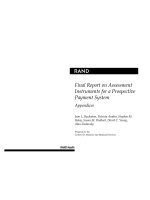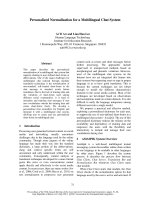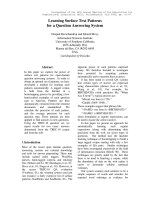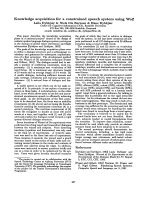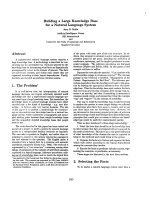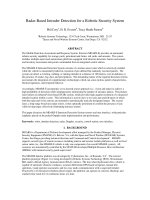Radar-Based Intruder Detection for a Robotic Security System Phil Corya, H. R. Everettb, Tracy Heath pptx
Bạn đang xem bản rút gọn của tài liệu. Xem và tải ngay bản đầy đủ của tài liệu tại đây (371.81 KB, 11 trang )
Radar-Based Intruder Detection for a Robotic Security System
Phil Cory
a
, H. R. Everett
b
, Tracy Heath Pastore
b
a
Robotic Systems Technology, 1234 Tech Court, Westminster, MD 21157
b
Space and Naval Warfare Systems Center, San Diego, CA 92152
ABSTRACT
The Mobile Detection Assessment and Response System, Exterior (MDARS-E) provides an automated
robotic security capability for storage yards, petroleum tank farms, rail yards, and arsenals. The system
includes multiple supervised-autonomous platforms equipped with intrusion detection, barrier assessment,
and inventory assessment subsystems commanded from an integrated control station.
The MDARS-E Intrusion Detection System consists of a motion sensor suite which is selectively enabled
while the vehicle is momentarily halted in execution of pre-defined but randomly executed patrols. The
system can detect a crawling, walking, or running intruder at a distance of 100 meters, even in darkness or
the presence of smoke, fog, dust, and precipitation. The demanding nature of the required detection criteria
necessitates the integration of complementary technologies which can sense motion, pattern characteristics,
thermal signatures, and temporal behavior.
Accordingly, MDARS-E incorporates a two-layered sensor approach (i.e., vision and radar) to achieve a
high probability of detection while simultaneously minimizing the number of nuisance alarms. The primary
layer utilizes an infrared/vision-based (FLIR) system, which provides high angular resolution of a suspected
intruder location within a scene. This information is used to slave a two-axis pan-and-tilt turret on which
both the radar and vision sensors are mounted to automatically track the designated target. The second
layer, a long-range broad-area radar sensor, is thus optimally positioned to confirm the presence of any
valid moving target, effectively eliminating nuisance alarms.
This paper discusses the MDARS-E Intrusion Detection System sensors and user interface, with particular
emphasis placed on the pulsed-Doppler radar implementation and performance.
Keywords:
robot, intruder detection, radar, Doppler, security, control station, user interface.
1. BACKGROUND
MDARS is a Department of Defense development effort managed by the Product Manager, Physical
Security Equipment (PM-PSE), Ft. Belvoir, VA, with the Space and Naval Warfare (SPAWAR) Systems
Center, San Diego providing technical direction and Command and Control development
1
. MDARS
supports several types of remote resources including interior and exterior mobile platforms as well as fixed
sensor suites (i.e., the MDARS-E vehicle is only one component of an overall MDARS system). All
resources are automatically controlled by the SPAWAR-developed Multiple Resource Host Architecture
(MRHA) with minimal security guard supervision
2
.
The MDARS-Interior platform was developed by Cybermotion, Inc., of Roanoke, VA
3
. The exterior
platform prototype (Figure 1) is being developed by Robotic Systems Technology (RST), Westminster,
MD, under a Broad Agency Announcement (BAA) contract. The four-wheel hydrostatic-drive vehicle is
capable of automatic obstacle avoidance, accurate differential-GPS-based navigation, manual tele-
operation, visual operator assessment, and two-way audio communication with a suspected intruder.
Powered by a 25-horsepower Kubota diesel engine, the platform can operate on concrete, blacktop, and
crushed stone roads for 12 continuous hours at a time.
Figure 1. The MDARS Exterior vehicle during recent testing at Aberdeen Proving Ground, MD, in
October 1998.
2. INTRUSION DETECTION SYSTEM
REQUIREMENTS
To provide a robust and dependable automated security system, the following performance requirements
were developed for the MDARS-E Intrusion Detection System (IDS):
1. Have a desired probability of detection (Pd) no less than 0.95 for level A (Maximum
Level Security) and B (Advanced Level) facilities, and 0.90 for level C (Intermediate
Level) and D (Basic Level) facilities.
2. Detect the motion of a human intruder when the MDARS-E platform is stationary:
• over a required range of 6.6 to 328 feet (2 to 100 meters),
• over a 360-degree field of view (FOV) around the platform,
• from horizontal to 45 degrees below horizontal,
• in normal (10
4
lux) to low-light-level (10
-3
lux) conditions,
• with a minimum target velocity of 0.1 miles per hour (0.147 feet/second).
3. Have a nuisance alarm rate (NAR) and false alarm rate (FAR) not to exceed one per
MDARS-E platform per shift.
4. Have an image-assessment capability to penetrate smoke, fog, dust, and precipitation.
3. INTRUDER DETECTION
The primary purpose of the Intruder Detection System is to reliably indicate the presence of an actual
intruder, while minimizing the number of false and nuisance alarms reported to the system operator. The
complementary intruder detection sensors (i.e., FLIR and radar) used on the MDARS-E platform
accomplish this objective using a combination of cross correlation, temporal assessment, and adaptive
thresholding
4
.
When the MDARS-E vehicle is patrolling an area, it periodically stops at randomly selected locations to
search for intruders, performing a step-and-stare function in which the turret sequentially positions the
sensors to cover a predefined field-of-regard in an incremental fashion. Once stabilized, the vision system
searches for any motion within its field-of-view. If no motion is detected, the turret is repositioned so that
the vision system can look at the adjacent wedge-shaped sector for motion, continuing in this fashion until
the entire scene has been scanned.
If motion is detected, a track file is started that describes the location of the potential threat, its pixel
geometry, and its persistence. Multiple track files are generated and maintained in the event that more than
one target is detected in the scene. The azimuthal information maintained in the track file representing the
most persistent target is used to slew the turret such that the potential intruder is positioned at the center of
the vision system FOV. The vision system sensor and radar system sensor are bore-sited such that the
central axis of their respective FOVs are co-aligned. The radar is then commanded to measure the target
characteristics of the potential threat so that it can be classified as either human or non-human. The sensor
configuration for the IDS is shown in Figure 2, with the radar system on the left of the turret and the FLIR
vision sensor on the right.
Figure 2. MDARS-E turret-mounted Intruder Detection System, with the radar on the left and FLIR sensor
on the right.
Intruder validation is accomplished by using sensory information supplied by both the vision and radar
systems. The vision system provides the geometric shape of the target and its angular location relative to
the vehicle, while the radar system measures the distance to the target and its relative velocity radial to the
vehicle. The target’s perceived geometric shape and distance are then used to calculate its cross section for
purposes of human target classification. (A reference cross-sectional area of 32 square feet is used to
account for the extreme case of a human with both arms and legs extended.) This complementary mix of
sensor technology allows for an intruder detection system that has greater than a 99-percent intruder
detection rate with less then a 1-percent false alarm rate.
4. USER INTERFACE
The MRHA control console (Figure 3) is a distributed processing system that coordinates the operation of
multiple interior and exterior remote platforms (i.e., semi-autonomous robots)
2
. The system is designed to
run automatically with minimal human oversight. High-level status information is provided for all the
platforms via the Supervisor Display, providing the user with a “big picture” of the patrolling platforms and
the secured areas as shown in Figure 4. User intervention is required only when a platform encounters an
exceptional condition such as a security breach. Any reported exceptional conditions are ranked according
to a site-specific prioritization scheme and automatically assigned in appropriate order to an Operator
Station Display, where the user is appraised of the situation and any appropriate response options. This
interface provides detailed operational and diagnostic information relevant to the situation at hand while
supporting one-on-one human control of the associated robotic platform.
Figure 3. MRHA Console installed for Early User Appraisal of the MDARS Interior system at Anniston
Army Depot, AL.
Figure 4.
MRHA Supervisor Display showing status for the exterior robot operating in vicinity of Building
F-36 at SPAWAR Systems Center in San Diego, CA.
When an IDS alarm is reported, an audible synthesized-speech announcement is made to capture the user’s
attention and provide pertinent information describing the event, including alarm certainty and intruder
range and bearing. (Alarm certainty is a percentage value indicating the confidence of a detection based on
analysis of fused sensor data.) This information, along with an intruder icon, is posted in the Status Window
on the Operator Station Display. The platform icon in the Map Window is color-coded red (green is
normal) and a red bearing vector is drawn on the map, originating at the platform and extending in the
direction of perceived detection. The Operator Station Display shown in Figure 5 indicates such an
intrusion alarm event.
Figure 5. MRHA Operator Station Display depicting an IDS Alarm for exterior robot #2.
The user can visually assess the situation by observing the Video Display Window on the right side of the
Operator Station Display. The IDS system automatically tracks the detected intruder, but the user can
override this feature to control the aim of the vision sensor by manipulating the joystick interface. A two-
way audio link is provided, enabling the user to aurally as well as visually monitor the scene, in addition to
speaking to the detected intruder for purposes of identification, assessment, and response.
5. RADAR FOR INTRUDER DETECTION
Electromagnetic energy in the 3-100 gigahertz (GHz) range has been used for years in conventional radar
(radio detecting and ranging) systems for a variety of applications. High-power military and commercial
radar sensors are typically combined with sophisticated signal processing, making them capable of excellent
range accuracy and target discrimination. The inherent ability to sense through smoke, dust, fog, and haze
make both microwave and millimeter-wave radar strong contenders for an active intrusion detection system
in exterior environments.
Microwave energy, widely used in military surveillance radar, navigational equipment, and tracking
systems, nominally spans the 3-30 GHz range, ideal for long-distance sensing due to longer wavelengths
which minimize atmospheric attenuation and blocking by precipitation and other adverse weather
conditions. Disadvantages of microwave systems include susceptibility to specular reflection, backscatter,
and multipath problems, reduced resolution when compared to millimeter wave radar, and longer
wavelengths that lead to bulky components and large antenna sizes
5
.
Millimeter-wave radars fall in the 30-300 GHz range, and due to their shorter wavelengths, have greater
atmospheric attenuation that results in significantly less range capability than microwave-based systems.
However, the shorter wavelengths lead to more accurate range and Doppler measurements, lower power
requirements, smaller system components, and reduced multipath and backscattering effects. In addition,
higher frequencies yield more narrow effective beamwidths, giving rise to more accurate information about
the nature of the surrounding targets
5
.
Intrusion detection and ranging using electromagnetic energy can be implemented through pulsed time-of-
flight (TOF), phase-detection, or frequency-modulation techniques. With TOF methods, the radar
transmitter is pulsed at a prespecified repetition rate, causing it to emit repetitive bursts of energy.
Returning energy reflected from a target is detected and processed to determine round-trip distance as a
function of elapsed propagation time. If the radar is phase coherent (i.e., the phase of the reflected energy is
known with respect to that of the transmitted energy), then it is also possible to calculate Doppler (target
velocity) information associated with each return. Millimeter-wave pulsed-Doppler radar of this type forms
a key part of the MDARS-E intruder detection system shown in Figure 6.
Figure 6. Close up of IDS radar on the MDARS-E turret.
6. MDARS MILLIMETER PULSED-DOPPLER RADAR
Referring to the high-level block diagram of Figure 7, the MDARS-E intruder detection radar consists of a
77-GHz pulsed-Doppler front-end developed by Millitech Corp., Deerfield, MA, with the back-end
interface, processing electronics, and digital signal processing (DSP) software developed by RST. The
system is packaged as an integrated unit (Figure 8) measuring 8.75 inches high by 6.75 inches wide by 9.75
inches long.
Millitech
77GHz Pulsed
Doppler Radar
Front End
RST
DSP Radar
Processing
Electronics
Clk Ref
Tri
g
In
Tri
g
Out
I
Q
RS232
Run/Halt
Intruder
Re
p
orts
Radar Return
Radar Pin
g
RF Si
g
nal
Figure 7.
High-level block diagram of MDARS-E Intruder Detection Radar System.
Figure 8 shows the DSP processing electronics mounted in the rear of the enclosure to ensure the analog-to-
digital conversion of the sensitive radar signals occurs very close to their source. System output is reduced
to simple intruder reports conveying target range and velocity that are sent over an RS232 interface to the
main computer system onboard the MDARS-E platform.
Figure 8. IDS Radar System processing electronics.
The radar processing electronics are based around an Analog Devices ADSP21060 SHARC processor,
high-speed analog-to-digital converters to sample the radar signals, and a complex programmable logic
device (CPLD) that controls the timing of the data acquisition system. A block diagram of the processing
electronics is shown in Figure 9. The ADSP21060 SHARC processor was chosen because it was
specifically designed to efficiently compute Fast Fourier Transforms (FFTs), which typically form the basis
of conventional radar signal processing.
Recall that pulsed-Doppler radar operates by transmitting an RF pulse (ping) and sampling the received
(reflected) signal at specified intervals. Each interval sampled for a single ping thus represents a range bin
corresponding to a specific target distance. The prototype MDARS system samples at a 40-MHz rate,
which equates to 12.5 feet between range bins as can be seen from the relationship:
D
RB
= (V
C
/F
SS
) / 2
The quantity V
C
is the speed of light, F
SS
is the sampling frequency of the radar signal, and their quotient is
divided by 2 due to the round trip path followed by the transmitted signal. Each returning Doppler pulse is
sampled 30 times in order to achieve a maximum detectable range of 375 feet (i.e., 30 range bins at 12.5
feet per bin). The Doppler pulse was sized to spread over multiple range bins to ensure that a moving target
anywhere within the radar FOV would be detected when sampling at 40 MHz. (A 35-nsec pulse is used,
which spreads across two to three range bins, depending on target location.)
AD9042
40 MSPS
12 Bit A/D
ADSP21060
SHARC
Processor 40MHz
Clk Ref
Tri
g
In
Tri
g
Out
I
Q
RS232
Run/Halt
Intruder
Re
p
orts
AD9042
40 MSPS
12 Bit A/D
Timing Control
CPLD
Flash
Memory
Serial
UART
512
KWord
SRAM
1K
FIFO
1K
FIFO
Figure 9
. Block Diagram of radar processing electronics.
Many samples of the radar signal are collected per range bin by continuously transmitting the pulse at a
specified Doppler sampling frequency
F
S
_
DOP
. The measured Doppler frequency shift
F
DOP
along with the
fixed radar transmit frequency
F
R
collectively yield the Doppler target velocity
V
DOP
from the relationship:
F
DOP
= 2 * F
R
* V
DOP
/ V
C
Both the
I
and
Q
components of the radar return (where
I
represents the in-phase real portion and
Q
the
quadrature imaginary portion) are sampled in order to maintain the sense of the Doppler frequency shift
(i.e., the direction, incoming or outgoing, of target velocity
V
DOP
)
6,7
. The Doppler frequency shift of a target
is measured by computing a complex FFT on each of the 30 range bins collected. The resultant FFT
spectrum for each range bin represents a velocity spectrum at a given range. Peaks found in the velocity
spectrum indicate the presence of a target at a velocity identified by the bin number of the peak (
N
PEAK
) in
the velocity spectrum for the given range bin. The FFT size (
N
FFT
) used is determined in conjunction with
the Doppler sampling frequency
F
S
_
DOP
to select the appropriate velocity resolution for the velocity
spectrum. The FFT size also affects the processing gain that can be achieved when computing the FFT, so
it should be made as large as practical.
The Doppler frequency shift measured relates to the Doppler sampling frequency and FFT size as follows:
F
DOP
= (F
S_DOP
/ N
FFT
) * N
PEAK
Equating this to the formulation of the Doppler frequency (as a function of radar frequency and Doppler
Velocity), the Doppler velocity can be determined, given the location of the velocity peak
N
PEAK
, within the
velocity spectrum as follows:
V
DOP
= (F
S_DOP
/ N
FFT
) * N
PEAK
* (V
C
/ F
R
) / 2
Once the FFT is performed on each of the 30 range bins, the resultant velocity spectrums for each bin are
processed to look for the most dominant target in the Doppler scan. The Doppler sampling frequency and
FFT size chosen can detect targets traveling up to 287 miles per hour, which well exceeds the MDARS
requirement for detecting humans moving about on foot. A large Doppler sampling frequency is used so
that larger narrow peaks are produced in the velocity spectrum. A slower Doppler sampling frequency
causes the energy to spread out in the velocity spectrum, which makes it more difficult to discern the most
dominant target.
Table 1. IDS Radar System Parameters
Radar Parameter Value Units
F
R
- Radar Transmit Frequency 77 Gigahertz (GHz)
F
S_DOP
- Doppler Sample Frequency 90 Kilohertz (KHz)
N
FFT
- FFT Size 2048 -
V
C
- Speed of Light 9.84 x 10
8
Feet/Second (ft/sec)
T
PULSE
– Radar Pulse Width 35 Nanosecond (nsec)
F
DOP
- Doppler Frequency Shift Measured Hertz (Hz)
V
DOP
- Corresponding Velocity for F
DOP
Measured Feet/Second (ft/sec)
N
PEAK
- Location of Peak in Velocity Spectrum Measured -
Each of the velocity spectrums are normalized so that peaks from one range bin can be compared against
peaks in another when searching for the largest Doppler radar return. The largest peak found is compared
against a threshold to determine if it is above the ambient radar power level and can therefore be designated
a valid target. The Doppler velocity is then calculated for the range bin in which the peak was found, after
which an associated target report is passed to the MDARS-E main computer system for subsequent
reporting to the MRHA console.
The pulsed-Doppler radar front-end has three 3-degree-horizontal by 3-degree-vertical phase-coherent
beams arranged horizontally such that a 7-degree-horizontal by 3-degree-vertical FOV is achieved with a 1-
degree overlap between each beam. The radar system sequences through each antenna, collecting 2048
samples for each of the 30 range bins per antenna. The processing architecture facilitates a pipelined flow of
radar data into the system such that I/Q data acquisition can be performed concurrently on one antenna
while FFT processing inside the SHARC is being performed on the data from a previous antenna.
0 5 10 15
0
500
1000
1500
Range: 87.5 ft
Power
0 5 10 15
0
500
1000
1500
Range: 100.0 ft
ft/sec
0 5 10 15
0
500
1000
1500
Range: 112.5 ft
Figure 10. Human target walking towards radar at 100 feet.
A throughput rate of 100 milliseconds per antenna can be sustained by the processing electronics. This
includes data acquisition of the I/Q data for each range bin, complex FFT and additional ancillary
processing, shuttling the data in and out of the SHARC processor, sifting through all the resultant velocity
spectrum data for target detection, plus generating and sending target reports over the RS232 interface.
Actual velocity spectrums measured by the radar system for a human walking at various distances are
shown in the Figures 10, 11, and 12. Three range bins are shown in the vicinity of the actual distance to
show how the target falls into multiple range bins.
0 5 10 15
-50
0
50
100
150
200
250
300
350
400
450
500
Range: 187.5 ft
Power
0 5 10 15
-50
0
50
100
150
200
250
300
350
400
450
500
Range: 200.0 ft
ft/sec
0 5 10 15
-50
0
50
100
150
200
250
300
350
400
450
500
Range: 212.5 ft
Figure 11. Human target walking towards radar at 200 feet.
0 5 10 15
-50
0
50
100
150
200
250
300
350
Range: 287.5 ft
Power
0 5 10 15
-50
0
50
100
150
200
250
300
350
Range: 300.0 ft
ft/sec
0 5 10 15
-50
0
50
100
150
200
250
300
350
Range: 312.5 ft
Figure 12. Human target walking towards radar at 300 feet.
7. CONCLUSION
Initial IDS tests conducted by both RST, SPAWAR, and the Army Test Center, Aberdeen, MD, have been
quite promising, with the system able to detect, track, and validate human intruders out to 100 meters with
an almost-zero nuisance alarm rate. The radar system has performed well in measuring the velocity and
distance to targets and detecting target motion, both radial and tangential to the radar antenna. The
demonstrated sensitivity makes it possible to positively detect a human crawling even in a tangential fashion
(i.e., Doppler systems are more sensitive to radial motion than tangential) at a distance of 100 meters.
Planned improvements in the MDARS IDS prototype include increased maximum range as well as
enhanced target tracking by utilizing the range and velocity measurements from the radar system to better
predict the direction of target travel.
8. REFERENCES
1. Inderieden, R.S., Everett, H.R., Heath-Pastore, T.A., Smurlo, R.P., “Overview of the Mobile Detection
Assessment and Response System,” DND/CSA Robotics and KBS Workshop, St. Hubert, Quebec,
Canada, October, 1995.
2. Laird, R.T., Gilbreath, G.A., Heath-Pastore, T.A., Everett, H.R., Inderieden, R.S., Grant, K., "MDARS
Multiple Robot Host Architecture," Association of Unmanned Vehicle Systems, 22nd Annual
Technical Symposium and Exhibition (AUVS '95), Washington, DC, July, 1995.
3. Holland, J.M., Martin, A., Smurlo, R.P., Everett, H.R., "MDARS Interior Platform," Association of
Unmanned Vehicle Systems, 22nd Annual Technical Symposium and Exhibition (AUVS '95),
Washington, DC, July, 1995.
4. Smurlo, R.P, Everett, H.R., "Intelligent Sensor Fusion for a Mobile Security Robot," Sensors, pp. 18-
28, March, 1994.
5. Everett, H.R., Sensors for Mobile Robots: Theory and Application, ISBN 1-56881-048-2, A.K.
Peters, Ltd., Wellesley, MA, June, 1995.
6. Edde, Byron, Radar Principles, Technology, Applications, Prentice Hall PTR, 1993.
7. Scheer & Kurtz, Coherent Radar Performance Estimation, Artech House, Inc., 1993.
Further author information:
P. C. : Email: ; Telephone: (410) 876-9200; Fax: (410) 876-9470
H. R. E.: Email: ; WWW: Telephone: (619) 553-3672;
Fax: (619) 553-6188
T. H. P.: Email: ; WWW: Telephone: (619) 553-3674;
Fax: (619) 553-6188


